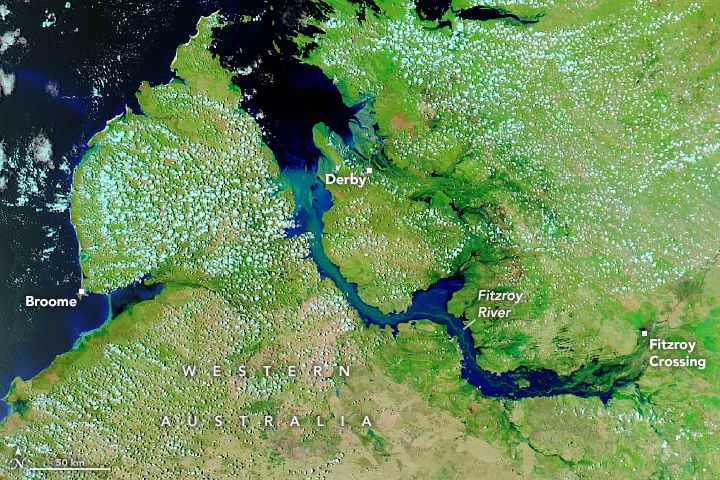Locum Doctors and GPs required urgently to assist victims of Kimberley Floods Australia
The recent flooding in Kimberley Western Australia has left hundreds of people homeless and created a demand for locum physicians, general practitioners and district medical officers with experience in emergency medicine, anaesthesia and obstetrics. If you can help out and have AHPRA registration and the right to work in Australia, please get in touch.

Tropical Cyclone Ellie Hits Australia
Starting on December 30, 2022, remnants of Tropical Cyclone Ellie brought days of torrential rain and wind to northern Western Australia. The deluge caused the Fitzroy River to swell to record-high levels, inundating floodplains and isolating several riverside communities.
The flooding is visible in this false-colour image (above), acquired on January 9, 2023, with the Moderate Resolution Imaging Spectroradiometer (MODIS) on NASA’s Aqua satellite. Water appears light to dark blue; vegetation is green and bare land is brown.
Flooding is common along rivers of the Kimberly region in Western Australia. But the amount of water delivered by the ex-tropical cyclone was exceptional. From December 30, 2022, through the first week of January 2023, rainfall totals across the region ranged from 200 to 500 millimeters (7.9 to 19.7 inches).
As a result, the Fitzroy River’s flow rate reached about 60,000 cubic meters per second—well above the 23,000 cubic meters per second usually seen during floods on this river, and one of the highest flow rates ever observed in any Australian river.
Australia’s Bureau of Meteorology reported that the river’s water levels near the town of Fitzroy Crossing peaked at a record-high 15.81 meters on January 4. That’s almost two meters higher than the previous record reached during flooding in 2002. At one point, the amount of water flowing down the Fitzroy River each day was the equivalent to the entire amount of water Perth uses in 20 years.
The floodwater left many roads and bridges impassable, isolating Fitzroy Crossing, Derby, Broome, and many of the region’s remote indigenous communities.
Tropical Cyclone Ellie first hit Australia’s Northern Territory as a category-1 storm on December 23, 2022. It then weakened into a tropical low before moving into Western Australia on December 30. By January 7, 2023, the former tropical cyclone had moved back into the Northern Territory and further weakened as it moved toward Queensland.
The recent flooding in Western Australia follows several severe flooding events that have occurred in eastern Australia during three consecutive years of La Niña conditions. La Niña usually brings wetter-than-average conditions to the country. 2022 was Australia’s ninth-wettest year on record.
Flooding and Homelessness in Kimberley
The chief executive of Kimberley Land Council, Tyronne Garstone, estimated that over 100 homes across the Kimberley were feared uninhabitable in the wake of ex-tropical cyclone Ellie. People have lost everything and flooded houses in the Kimberley could be uninhabitable for months due to the nationwide shortage of the skilled trades people needed to repair the properties.
The problem of potential homelessness is further exacerbated by housing shortages which have been at crisis levels for decades, leaving many families with no choice but to live in one house. Many people in the area live in multigenerational homes or with extended family. It is not uncommon to have 10 to 15, sometimes 20 people living in one house.
Australian Prime Minister Anthony Albanese has travelled to the area hit by the extraordinary volume of water, saying he has seen "massive infrastructure damage". Meanwhile helicopters bring food and other supplies to isolated communities.
WA State Government Directive for Locum Doctors in Derby and Fitzroy Crossing
The Kimberly and the WA State government are currently facilitating the return of residents to their respective communities and their homes whilst aiding with the vast clean up required.
There has been a directive issued to ensure that the respective medical facilities ( Derby and Fitzroy Crossing) are well staffed, as with any state of emergency there is always more pressure on the medical facilities.
Current requirements are for locum physicians to start work on January 30th 2023 with on going requirements until April at least. We are looking for the following categories of doctors:
- District Medical Officers (DMOs)
- General Practitioners (GPs)
- junior doctors with experience in emergency medicine, anaesthetics and obstetrics
Locum doctors can work for a short or long time in either or both of the rural hospitals in the affected region: Fitzroy Crossing Hospital and the slightly larger Derby Hospital.
Locum Eligibility Requirements
To be eligible to apply for these positions you must meet the following criteria:
- hold full AHPRA registration
- have the right to work in Australia
- have clinical experience in rural and remote settings / Aboriginal health issues / working in ED
- Current ED CME qualifications e.g. ALS2, ATLS, APLS, PROMPT, EMST, EMET, Rural Emergency Simulation Training (REST) - for emergency physicians only
- Current criminal record screening
Locum Remuneration
Pay rates are A$ 2700-3000 per day with the exact rate depending upon the employer's review of the candidate's experience and qualifications. Travel and accommodation is also covered.
Fitzroy Crossing Hospital
Fitzroy Crossing is a small town in the Kimberley region of Western Australia, 400 kilometres (250 mi) east of Broome and 300 kilometres (190 mi) west of Halls Creek. It is approximately 2,524 kilometres (1,568 mi) from the state capital of Perth. It is 114 metres (374 ft) above sea level and is situated on a low rise surrounded by the vast floodplains of the Fitzroy River and its tributary Margaret River. It has a climate that is in transition between a tropical monsoon climate (Am) and a semi-arid climate and temperatures range from 35-47 C.
The population of the Fitzroy Crossing town-site is approximately 1500 people with a further 2,000 living in up to 50 Aboriginal communities scattered throughout the Fitzroy Valley. About 80% of the Fitzroy Valley population are Indigenous Australians. In the townsite the ratio is 60/40 indigenous/non-indigenous. Tourism, cattle stations and mining are the main industries in the area.
Fitzroy Crossing serves as the hub for the communities of the Fitzroy Valley. Many residents come into town for recreational activities, such as fishing and sports at the recreation centre, shopping (mainly for groceries), visiting family, and meetings or appointments at the hospital or other government agencies. Fitzroy Crossing is also home to many regional service providers because it is a central location to these communities.
The township of Fitzroy Crossing contains most amenities with two roadhouses, a self-serve 24-hour diesel station, supermarket, post office, newsagent, clothes shops, accommodation, mechanics, electricians, plumbers, and cafes and restaurants.
Fitzroy Crossing also has a swimming pool, covered basketball courts, a grassed Australian rules football oval, and many grassed areas around the town for public use.
The new
Fitzroy Crossing Hospital was opened in 2008 and replaced the old 8 bed facility with a larger capacity building which includes 12 acute inpatient beds, two boarder beds, and emergency department primary health care and public dental clinics.
The emergency department has two treatment bays, a dedicated resuscitation room and five consulting rooms for outpatient clinics. This is significantly larger than the old ED, which had only one treatment bay and two consulting rooms. The consulting rooms are used to provide GP consultations and appointments with visiting specialists in areas including cardiology, orthopaedics, paediatric, ophthalmology, obstetrics and mental health.
The hospital is staffed with four doctors, 15 nurses, and 13 primary health staff, including nine community health nurses, who provide services to the Fitzroy community from the hospital. The dental clinic has two chairs and a full-time dentist and dental clinic assistant to provide a high quality dental service to the community.
The hospital also features an undercover ambulance entry, mortuary with a private grieving courtyard and a transit lounge where patients can rest before travelling to other health services or outlying communities.
The Nindilingarri Cultural Health Service occupies a new building adjoining the hospital. This improves access to health services for the indigenous population by enabling their primary and acute health care needs to be met in the one, convenient and culturally appropriate location. It also means that the clinical services offered at the hospital can work closely with the primary health and education programs run by the Nindilingarri Cultural Health Service.
Nindilingarri Cultural Health Services (NCHS) is an Aboriginal Community Controlled Health Organisation (ACCHO). It began in 1995, following a wide reaching community consultation which aimed to establish the type of health service the local Community wanted. The clear message from this consultation was that the community wanted a holistic, culturally appropriate service that recognises the impact of Aboriginal Law, Culture, Spirit and Land issues on the health of the Community. The Community also specified that they wanted an ACCHO that focused on disease prevention and health promotion. Most importantly, they wanted a service that worked together with the existing, state run, hospital service to avoid duplication of services and improve the quality of services for local people. It was from this consultation that the concept of a partnership between the Fitzroy Valley Health Service (FVHS) and NCHS was formed.
Derby Hospital
The Derby Hospital is a 35 bed rural integrated health facility with emergency department, delivery suite and operating theatre and clinics for the provision of primary and secondary medical services. A recently built $3.7 million building, located adjacent to the Derby Hospital, includes two consult rooms, an immunisation clinic room for adult and child immunisations, a child health clinic room, and a multipurpose training and therapy room.
The town of Derby, in the Kimberly region of Western Australia was founded in 1883 and named after Edward Stanley, 15th Earl of Derby, the British secretary of state for the colonies. Derby was famous in the 1920s as the terminus of the first scheduled aviation service in Australia, West Australian Airways Ltd. Their service began with their first flight on 5 December 1921, which crashed, near Geraldton. At one time the Perth to Derby service was the world's longest passenger airline route.
In 1968 the town had a population of approximately 1,500 people, many employed at the meat works. A A$900,000 beef road from Glenroy Station to Derby was completed the same year to assist with the development of beef processing. A A$2 million steel and concrete jetty was built in 1965 to provide adequate port facilities for the shipment of live cattle.
At the 2016 census, Derby had a population of 3,325 with 47.2% of Aboriginal and Torres Strait Islander descent. Along with Broome and Kununurra, it is one of only three towns in the Kimberley to have a population over 2,000. Located on King Sound, Derby has the highest tides in Australia, with the differential between low and high tide reaching 11.8 metres.
Derby has a hot semi-arid climate with a short, highly variable wet season lasting from late December to March.
The economy is based upon the pastoral and mining industries, as well as administration and tourism. There is oil at Blina, diamond mining at Ellendale. Granite is quarried from the Wunaamin-Miliwundi Ranges and lead and zinc from Cadjebut and an iron ore mine at Koolan Island. A major mineral sands mining project is being developed at Thunderbird, 100 kilometres (62 mi) west of Derby. Tourism bolsters the local economy between the months of May and September.
The Derby Leprosarium on the outskirts of the town was one of two in Western Australia that helped to contain an epidemic of leprosy from the 1930s to the 1960s.
Advantages of Working as a Locum Doctor in the Kimberley WA
Working as a locum doctor in rural and remote areas of Australia offers the unrivalled experience of unique challenges and clinical learning experiences which develop confidence, resilience and initiative. Under normal circumstances there are complex problems in rural medical practice but these are accentuated in times of crisis.
A locum in Derby or Fitzroy Crossing will give you the rare opportunity to learn and utilise the skills required for humanitarian relief in the context of an environmental disaster and make a substantial contribution to the recovery of this isolated and often neglected community.
You can also expect generous rates of pay and excellent working conditions, the opportunity to excel at working within a close knit and supportive team and time off to explore the natural beauty of the environment.
Read more detailed information about the
advantages and disadvantages of locum medical work and
contact us for further information about locum availability, pay rates and credentials requirements. You can
register your CV for future opportunities.
Share this post on Social Media
Leave a Comment
SEARCH JOBS
Ready for a change? Whether you’re looking for higher compensation, greater autonomy, a better work-life balance, or just a change in scenery, we have job opportunities in wonderful locations across the world. Start your medical or dental job search today and embark on your next career move.
SIGN UP FOR JOB ALERTS
We believe everyone deserves to find their dream job. Be the first to hear about new practice opportunities in exciting locations across the world Simply sign up for job alerts in your chosen field, and we will email you when a new job in your specialty becomes available.
More Insights












